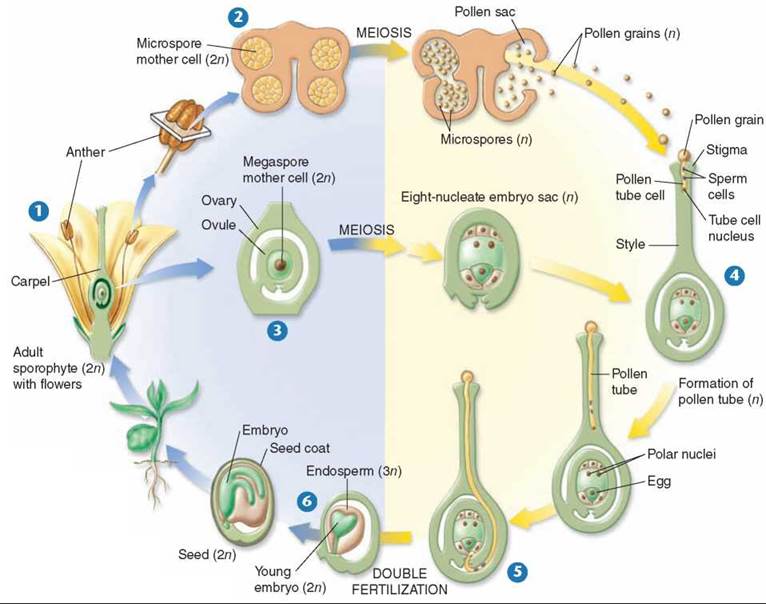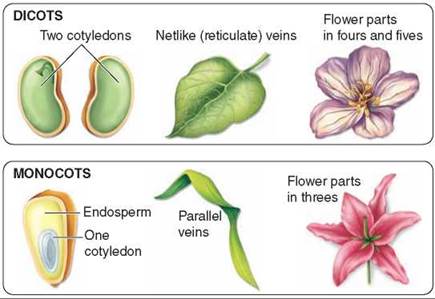THE LIVING WORLD
Unit Seven. Plant Life
32. Evolution of Plants
32.10. Double Fertilization
The seeds of gymnosperms often contain food to nourish the developing plant in the critical time immediately after germination, but the seeds of angiosperms have greatly improved on this aspect of seed function. Angiosperms produce a special, highly nutritious tissue called endosperm within their seeds. Here is how it happens. The angiosperm life cycle is presented in figure 32.17, but there are actually two parts to the cycle, a male and a female part, indicated by the two sets of arrows at the top of the cycle. We’ll begin with the flower of the sporophyte on the left side of the cycle 1. The development of the male gametophyte (the pollen grain) occurs in the anthers and is indicated in the upper set of arrows. The anthers are shown in cross section in 2 so you can see the microspores mother cells that develop into pollen grains. The pollen grain contains two haploid sperm. Upon adhering to the stigma at the top of the carpel (the female organ in which the egg cell is produced), the pollen begins to form a pollen tube 4. The yellow pollen tube grows down into the carpel until it reaches the ovule in the ovary 5. The two sperm (the small purplish cells) travel down the pollen tube and into the ovary. The first sperm fuses with the egg (the green cell at the base of the ovary), as in all sexually reproducing organisms, forming the zygote that develops into the embryo. The other sperm cell fuses with two other products of meiosis, called polar nuclei, to form a triploid (three copies of the chromosomes, 3n) endosperm cell. This cell divides much more rapidly than the zygote, giving rise to the nutritive endosperm tissue within the seed (the tan material surrounding the embryo 6). This process of fertilization with two sperm to produce both a zygote and endosperm is called double fertilization. Double fertilization forming endosperm is exclusive to angiosperms.

Figure 32.17. Life cycle of an angiosperm.
In angiosperms, as in gymnosperms, the sporophyte is the dominant generation. Eggs form within the embryo sac, inside the ovules 3, which, in turn, are enclosed in the carpels. The carpel is differentiated in most angiosperms into a slender portion, or style, ending in a stigma, the surface on which the pollen grains germinate 4. The pollen grains, meanwhile, are formed within the anthers 2 and complete their differentiation to the mature, three-celled stage either before or after grains are shed. Fertilization is distinctive in angiosperms, being a double process 5. A sperm and an egg come together, producing a zygote; at the same time, another sperm fuses with the two polar nuclei, producing the primary endosperm nucleus, which is triploid. The zygote and the primary endosperm nucleus divide mitotically, giving rise, respectively, to the embryo and the endosperm 6. The endosperm is the tissue, almost exclusive to angiosperms, that nourishes the embryo and young plant.
In some angiosperms, such as the common pea or bean, the endosperm is fully used up by the time the seed is mature. Food reserves are stored by the embryo in swollen, fleshy leaves called cotyledons, or seed leaves. In other angiosperms, such as corn, the mature seed contains abundant endosperm, which is used after germination. It also contains a cotyledon, but its seed leaf is used to protect the plant during germination and not as a food source.
Some angiosperm embryos have two cotyledons, and are called dicotyledons, or dicots. The first angiosperms were like this. Dicots typically have leaves with netlike branching of veins and flowers with four to five parts per whorl (figure 32.18, top). Oak and maple trees are dicots, as are many shrubs.
The embryos of other angiosperms, which evolved somewhat later, have a single cotyledon and are called monocotyledons, or monocots. Monocots typically have leaves with parallel veins and flowers with three parts per whorl (figure 32.18, bottom). Grasses, one of the most abundant of all plants, are wind-pollinated monocots. There are also differences in the organization of vascular tissue in the stems of monocots and dicots, which will be compared in more detail in chapter 33.

Figure 32.18. Dicots and monocots.
Dicots have two cotyledons and netlike (reticulate) veins. Their flower parts occur in fours and fives. Monocots are characterized by one cotyledon, parallel veins, and the occurrence of flower parts in threes (or multiples of three).
Key Learning Outcome 32.10. Two sperm fertilize each angiosperm ovule. One fuses with the egg to form the zygote, the other with two polar nuclei to form triploid (3n) nutritious endosperm.